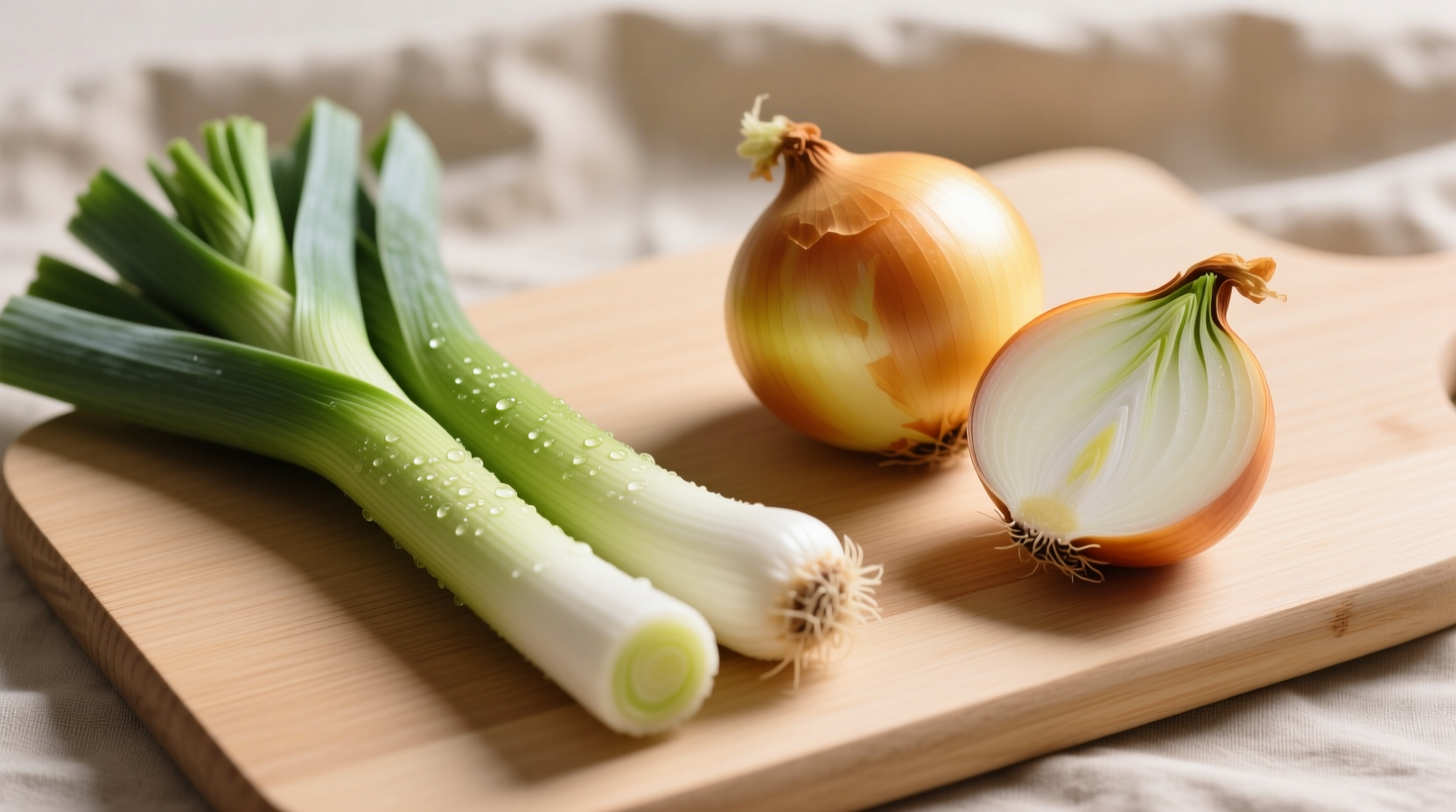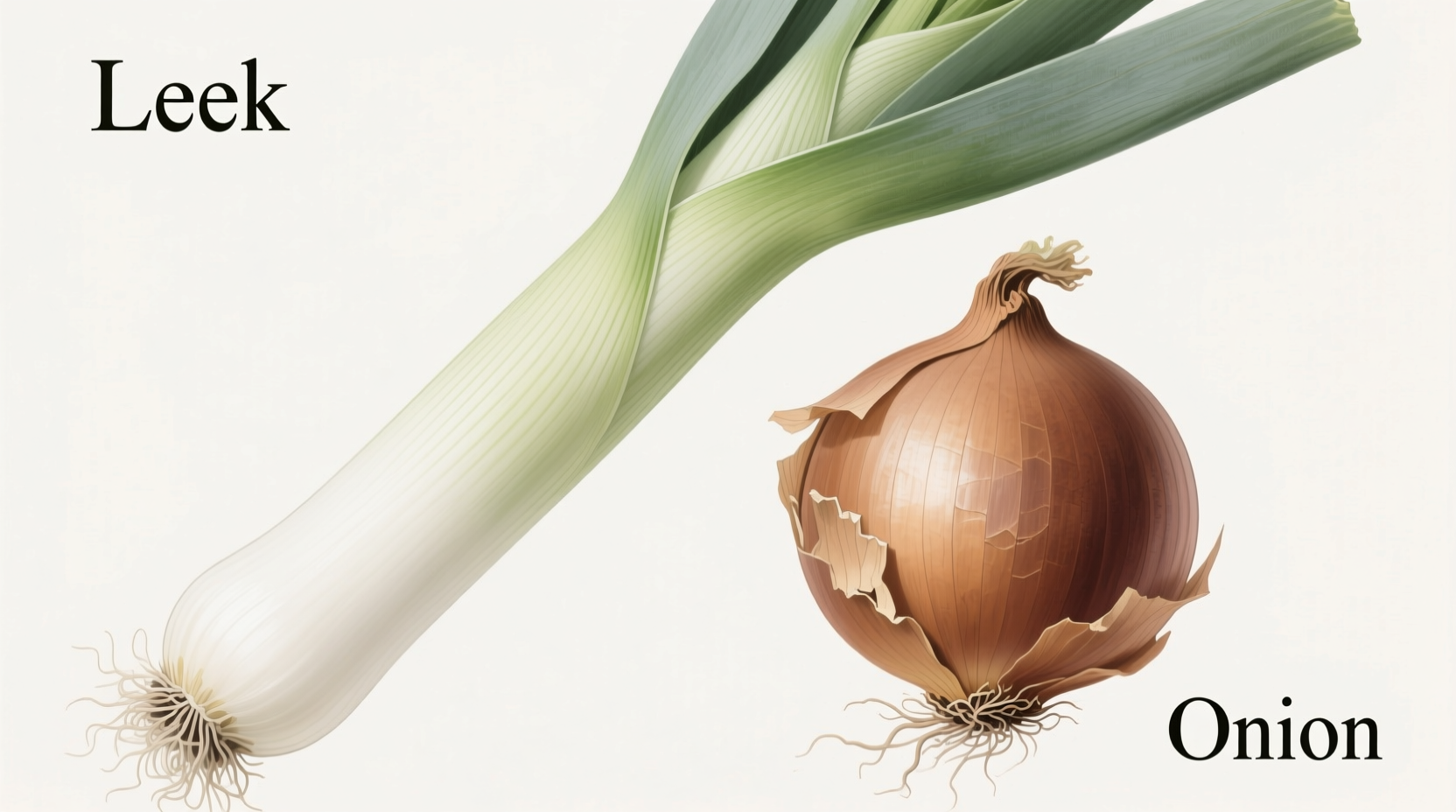Confused about whether leeks qualify as onions? You're not alone. Many home cooks treat these alliums interchangeably, but they're actually distinct vegetables with unique properties. Let's clarify the botanical relationship and practical differences that matter in your kitchen.
Botanical Classification: Understanding the Allium Family Tree
Leeks and onions both belong to the Allium genus within the Amaryllidaceae family, but they're different species. This relationship is similar to how wolves and domestic dogs are related but distinct animals. According to the USDA Agricultural Research Service, the Allium genus contains over 850 species, with only a dozen commonly cultivated for food.
| Allium Type | Scientific Name | Key Characteristics |
|---|---|---|
| Leek | Allium ampeloprasum var. porrum | Elongated cylindrical stalk, mild flavor, no bulb formation |
| Onion | Allium cepa | Distinct spherical bulb, stronger pungency, layered structure |
| Garlic | Allium sativum | Clove structure, intense flavor, medicinal properties |
| Chives | Allium schoenoprasum | Hollow tubular leaves, delicate onion flavor |
Physical and Flavor Differences You Can Taste
While onions develop that characteristic layered bulb underground, leeks grow as elongated cylindrical stalks with no significant bulb formation. This structural difference creates notable variations in both texture and flavor:
- Flavor intensity: Leeks offer a milder, sweeter profile compared to onions' sharper bite
- Texture: Leeks maintain better structural integrity when cooked
- Edible portions: You use nearly the entire leek (white and light green parts), while onions are primarily the bulb
- Preparation: Leeks require thorough cleaning to remove trapped soil between layers

Nutritional Comparison: Health Benefits Breakdown
Both vegetables provide valuable nutrients, but with some important distinctions. Data from the USDA FoodData Central shows these nutritional differences per 100g raw:
| Nutrient | Leeks | Onions | Significance |
|---|---|---|---|
| Calories | 61 kcal | 40 kcal | Leeks slightly higher due to water content |
| Vitamin K | 47 μg (58% DV) | 0.4 μg (0.5% DV) | Leeks provide substantially more blood-clotting vitamin |
| Vitamin A | 160 μg (18% DV) | 0 μg | Leeks contain beta-carotene from green portions |
| Quercetin | Moderate | High | Onions contain more of this antioxidant compound |
Culinary Applications: When to Use Each
Understanding the practical differences helps you make better cooking decisions. Professional chefs follow these guidelines for optimal results:
Best Uses for Leeks
- As a primary ingredient in soups and stews (like classic vichyssoise)
- When you want subtle allium flavor without overpowering other ingredients
- In dishes requiring longer cooking times where onions might become too strong
- As a milder alternative in raw preparations like salads
Best Uses for Onions
- When you need that characteristic sharp allium bite
- For caramelizing (onions develop richer sweetness)
- In salsas and raw preparations where stronger flavor is desired
- As a base for sauces and gravies requiring robust flavor
Substitution Guidelines: Making Smart Swaps
While you can substitute one for the other in many recipes, understanding the limitations prevents culinary disappointment. Based on testing in professional kitchens:
- Leeks for onions: Use 1.5x the amount of leeks when substituting for onions, focusing on the white and light green parts
- Onions for leeks: Use only half the amount of onions when substituting for leeks to avoid overpowering the dish
- Important limitation: Never substitute leeks for onions in recipes requiring the structural integrity of onion rings or where the distinct onion flavor profile is essential (like French onion soup)
Common Misconceptions Clarified
Several myths persist about these vegetables. Let's set the record straight:
- Myth: Leeks are just oversized scallions Fact: While both have similar appearance, scallions (Allium fistulosum) are a different species with hollow leaves and no bulb development
- Myth: The green parts of leeks are inedible Fact: The darker green portions are completely edible and packed with nutrients—they just require longer cooking to become tender
- Myth: Leeks and onions have identical growing requirements Fact: Leeks need longer growing seasons (120+ days) compared to most onions (90-100 days) and prefer cooler temperatures
Practical Tips for Cooking Success
Maximize your allium experience with these professional techniques:
Proper Leek Preparation
- Slice off root end and dark green tops (save for stock)
- Cut lengthwise through the white and light green portion
- Rinse thoroughly under running water, separating layers to remove trapped soil
- Soak in cold water for 5-10 minutes to dislodge any remaining dirt
Flavor Maximization Techniques
- For soups and stews: Sauté leeks slowly in butter until translucent but not browned
- For roasted dishes: Toss leek sections with olive oil and roast at 400°F until caramelized
- To preserve nutrients: Steam leeks briefly rather than boiling
- For layered flavor: Use leeks as the aromatic base, then add onions later in the cooking process
Storage and Seasonality Guide
Understanding availability and proper storage extends your allium enjoyment:
- Peak season: Leeks are primarily a fall and winter vegetable, while onions have year-round availability
- Storage: Keep unwashed leeks in the refrigerator crisper drawer for 1-2 weeks; store onions in a cool, dark, dry place for 1-2 months
- Freezing: Blanch leeks before freezing; onions freeze best when diced and sautéed first
- Signs of freshness: Crisp, firm stalks with vibrant green tops indicate quality leeks; onions should feel heavy for their size with dry, papery skins
Conclusion: Respecting Each Vegetable's Unique Qualities
While leeks and onions share botanical heritage in the Allium family, they're distinct vegetables with unique characteristics. Recognizing that leeks aren't simply "big onions" but rather a separate species with milder flavor and different culinary applications elevates your cooking. By understanding their differences in structure, flavor profile, and best uses, you can make more informed ingredient choices that enhance your dishes rather than compromise them. Whether you're building flavor foundations for soups or creating delicate sauces, selecting the right allium makes all the difference in achieving professional-quality results at home.
Can I substitute leeks for onions in all recipes?
No, substitution depends on the recipe. Leeks work well in soups, stews, and dishes where milder flavor is desired, but they don't caramelize as effectively as onions. For French onion soup or dishes requiring strong onion flavor, substitution isn't recommended. When substituting, use 1.5x leeks for onions or half the amount of onions for leeks.
Why do my leeks taste bitter?
Bitterness usually comes from improper cleaning or using too much of the dark green portion without adequate cooking. Leeks trap soil between layers, which can cause bitterness if not thoroughly rinsed. The darker green parts also contain more bitter compounds and require longer cooking to become tender and sweet.
Are leeks healthier than onions?
Both offer health benefits with different nutritional profiles. Leeks provide significantly more vitamin K and vitamin A (from beta-carotene), while onions contain higher levels of quercetin and certain sulfur compounds. For overall nutrition, incorporating both into your diet provides complementary benefits rather than one being definitively "healthier" than the other.
How do I properly clean leeks?
First, trim off roots and dark green tops. Cut leeks lengthwise through the white and light green portion, then separate the layers. Rinse thoroughly under running water while separating layers to remove trapped soil. For stubborn dirt, soak in a bowl of cold water for 5-10 minutes, then lift leeks out (don't pour, as dirt will resettled).
What's the difference between leeks and ramps?
Ramps (wild leeks) are a different species (Allium tricoccum) with a stronger garlic-onion flavor. They're smaller, have a purple stem base, and feature a single broad leaf rather than multiple tubular leaves. Ramps are seasonal spring delicacies, while cultivated leeks are available fall through spring. Ramps have a more intense flavor that works well in small quantities.











 浙公网安备
33010002000092号
浙公网安备
33010002000092号 浙B2-20120091-4
浙B2-20120091-4